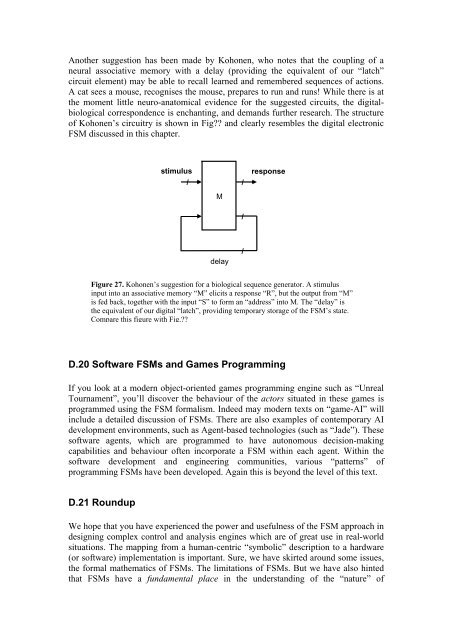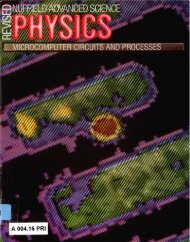Chapter D Finite State Machines
Chapter D Finite State Machines
Chapter D Finite State Machines
- No tags were found...
Create successful ePaper yourself
Turn your PDF publications into a flip-book with our unique Google optimized e-Paper software.
Another suggestion has been made by Kohonen, who notes that the coupling of aneural associative memory with a delay (providing the equivalent of our “latch”circuit element) may be able to recall learned and remembered sequences of actions.A cat sees a mouse, recognises the mouse, prepares to run and runs! While there is atthe moment little neuro-anatomical evidence for the suggested circuits, the digitalbiologicalcorrespondence is enchanting, and demands further research. The structureof Kohonen’s circuitry is shown in Fig?? and clearly resembles the digital electronicFSM discussed in this chapter.stimulus/M//responsedelay/Figure 27. Kohonen’s suggestion for a biological sequence generator. A stimulusinput into an associative memory “M” elicits a response “R”, but the output from “M”is fed back, together with the input “S” to form an “address” into M. The “delay” isthe equivalent of our digital “latch”, providing temporary storage of the FSM’s state.Compare this figure with Fig.??D.20 Software FSMs and Games ProgrammingIf you look at a modern object-oriented games programming engine such as “UnrealTournament”, you’ll discover the behaviour of the actors situated in these games isprogrammed using the FSM formalism. Indeed may modern texts on “game-AI” willinclude a detailed discussion of FSMs. There are also examples of contemporary AIdevelopment environments, such as Agent-based technologies (such as “Jade”). Thesesoftware agents, which are programmed to have autonomous decision-makingcapabilities and behaviour often incorporate a FSM within each agent. Within thesoftware development and engineering communities, various “patterns” ofprogra mming FSMs have been developed. Again this is beyond the level of this text.D.21 RoundupWe hope that you have experienced the power and usefulness of the FSM approach indesigning complex control and analysis engines which are of great use in real-worldsituations. The mapping from a human-centric “symbolic” description to a hardware(or software) implementation is important. Sure, we have skirted around some issues,theformal mathematics of FSMs. The limitations of FSMs. But we have also hintedthat FSMs have a fundamental place in the understanding of the “nature” of











